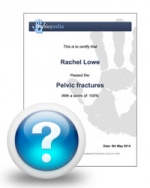Clinical Guidelines: Difference between revisions
Scott Buxton (talk | contribs) No edit summary |
Scott Buxton (talk | contribs) No edit summary |
||
| Line 1: | Line 1: | ||
<div class="editorbox"> | <div class="editorbox"> | ||
'''Original Editor '''- [[User:User: | '''Original Editor '''- [[User:User:Steffen Kistmacher|Steffen_Kistmacher]] | ||
'''Top Contributors''' - {{Special:Contributors/{{FULLPAGENAME}}}} | '''Top Contributors''' - {{Special:Contributors/{{FULLPAGENAME}}}} | ||
| Line 88: | Line 88: | ||
[http://members.physio-pedia.com/quizzes/osteoporosis/ Go to Quiz] | [http://members.physio-pedia.com/quizzes/osteoporosis/ Go to Quiz] | ||
This quiz is in combination with this page [http://www.physio-pedia.com/Evidence_Based_Practice(EBP)_in_Physiotherapy EBP in Physiotherapy] | This quiz is in combination with this page [http://www.physio-pedia.com/Evidence_Based_Practice(EBP)_in_Physiotherapy EBP in Physiotherapy] | ||
<br> | <br> | ||
| Line 95: | Line 95: | ||
|} | |} | ||
</div> | </div> | ||
== References == | |||
<references /> | |||
[[Category:EBP]] | |||
Revision as of 13:26, 21 November 2014
Original Editor - Steffen_Kistmacher
Top Contributors - Evan Thomas, Admin, Naomi O'Reilly, Rachael Lowe, Kim Jackson, Vidya Acharya, Steffen Kistmacher, Sheik Abdul Khadir, Scott Buxton, Oyemi Sillo, Tarina van der Stockt and Tony Lowe
Introduction[edit | edit source]
The standard definition of Clinical Practice Guidelines (CPGs) is "systematically developed statements to assist practitioners and patient decisions about appropriate health care for specific circumstances"[1]. Guidelines are designed to support the decision-making processes in patient care. The content of a guideline is based on a systematic review of clinical evidence - the main source for evidence-based care.
The benefits of clinical practice guidelines include[2]:
- Improve clinical outcomes[3]
- Reduce variability in clinical practice[4]
- Increase use of known effective interventions[3]
- Provide greater cost effectiveness[3]
- Increase transparency of evidence to justify interventions[2]
- Legitimise profession in eyes of external stakeholders[4]
Clinical Guidelines are important to physiotherapists because they[5]:
- Provide quick access to synthesis of evidence
- Give the clinicain direct access to the knowledge-base of the experts
- Allow one to self-assess their current practice
- Assist with developing direction of future clinical research
Clinical Guidelines can be found at:
- PEDro
- Canadian Medical Association Infobase of Clinical Practice Guidelines
- G-I-N International Guideline Library
- New Zealand Guidelines Group
- AHRQ National Guideline Clearinghouse
- National Institute for Health and Clinical Excellence (NICE)
- Scottish Intercollegiate Guidelines Network (SIGN)
- National Health and Medical Research Council
Many guidelines from the above databases have been collected here in Physiopedia.
Published Clinical Practice Guidelines by Speciality[edit | edit source]
- Musculoskeletal / Orthopaedics
- Cardiopulmonary
- Neurology
- Paediatrics
- Rheumatology
- Elderly Care
- Endocrine / Metabolic
- Pain Science
- Womens Health
- Pelvic Health
- Oncology
- Extended Scope
- Health Promotion
- Modalities
- Mental Health
- Amputees
- Diagnostic Imaging
Internationalization[edit | edit source]
It is easy to find evidence-based guidelines for physiotherapy practice (e.g. using PEDro) and there are many evidence-based guidelines for physiotherapy practice but there appears to much replication.
In 2011 an international collaboration for the development of evidence-based recommendations for physiotherapy diagnosis and treatment was proposed[6] and presented at the World Physical Therapy Congress. The rationale for this was:
- Rapid growth of body of knowledge for evidence-based physiotherapy
- Translation of evidence into recommendations for clinical practice in guidelines by several professional bodies
- International collaboration in the Guidelines International network (G-I-N)
- International collaboration in physical therapy is still limited
For internationally accepted clinical guidelines to be relevant, “room” must be made for those that don’t fit into the “developed world” model. The “developing world” has unique challenges that need to be considered and become part of internationally relevant guidelines[7]. It is important that we remember the limitations in practice setting, delivery, competency and several other issues faced in places where the physiotherapy profession is in evolution[8].
Resources[edit | edit source]
Read 4 Credit[edit | edit source]
|
Would you like to earn certification to prove your knowledge on this topic? All you need to do is pass the quiz relating to this page in the Physiopedia member area. This quiz is in combination with this page EBP in Physiotherapy
|
References[edit | edit source]
- ↑ Field MJ, Lohr KN (Eds). Clinical Practice Guidelines: Directions for a New Program, Institute of Medicine, Washington, DC: National Academy Press, 1990.
- ↑ 2.0 2.1 Moore, A. Development of evidence statements for physical therapy diagnosis and treatment: What are evidence statements and how do they fit in with the policy of professional bodies? WPT Congress, June 2011, Amsterdam.
- ↑ 3.0 3.1 3.2 Potential Benefits, Limitations and Harms of Clinical Guidelines. Woolf SH, Grol G, Hutchinson A, Eccles M, Grimshaw J. BMJ, 1999; 318(7182): 527–530.
- ↑ 4.0 4.1 Clinical Practice Guidelines - Do they Enhance Value for Money in Health Care? Grimshaw JM, Hutchinson A. Br Med Bull, 1995; 51: 927-940.
- ↑ Christopher M Powers. Development of Evidence-Based Practice Guidelines for the Treatment of Common Musculoskeletal Conditions: Experiences of the Orthopaedic Section of the APTA. WPT Congress, June 2011, Amsterdam.
- ↑ Development of Clinical Guidelines in Physical Therapy: Perspective for International Collaboration. Van der Wees PJ, Moore AP, Powers CM, Stewart A, Nijhuis-van der Sanden MWG, de Bie RA. Physical Therapy, 2011; 91(10): 1551-1563.
- ↑ Aimee Stewart. Applicability of existing evidence in low and middle income countries. Focused Symposia, WPY Congress, June 2011, Amsterdam.
- ↑ Srikesavan Sabapathy. In conversation via the Physiopedia Facebook page, March 2012.







